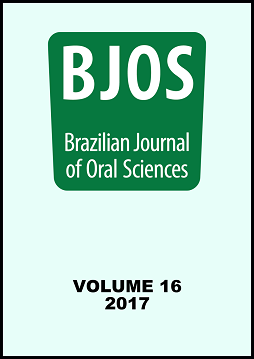Abstract
Self-adhesive, dual-polymerizing resin cements require no treatment to the prepared tooth surfaces before cementation. Aim: The aim of this study was to evaluate the influence of curing mode on bond strength (BS) of three cementing systems to bovine dentin. Methods: The buccal enamel surfaces of 50 bovine incisors were removed to expose dentin and to flat the surface. The teeth were divided into five groups (n=10), which consisted of two resin cements (Multilink and Clearfil SA Cement) that were tested in dual- (halogen light for 40 s) and self-cured modes, and a control (RelyX ARC). Two cylinders of resin cements (1.0 mm X 0.75 mm) were prepared on each bonded dentin surface. After 24h at 37oC, resin cylinders were subjected to micro-shear testing in a universal testing machine (4411/Instron - 0.5 mm/min). Data were statistically analyzed by two-way ANOVA, Tukey and Dunnett`s test (5%). Results: Multilink showed higher BS than those observed on Clearfil SA. Light-curing resulted in higher BS for both Multilink and Clearfil SA. When Multilink was light-cured, no significant difference on BS was demonstrated between it and RelyX ARC. Conclusions: The highest BS values were obtained in control group and light-cured Multilink resin cement.References
Marthaler TM. Changes in Dental Caries 1953–2003. Caries Res. 2004 May-Jun;38(3):173-81.
Hugoson A, Koch G, Helkimo AN, Lundin SA. Caries prevalence and distribution in individuals aged 3–20 years in J nk ping, Sweden, over a 30-year period (1973–2003). Int J Paediatr Dent. 2008 Jan;18(1):18-26.
Simonsen RJ, Neal RC. A review of the clinical application and performance of pit and ssure sea- lants. Aust Dent J. 2011 Jun;56 Suppl 1:45-58. doi: 10.1111/j.1834-7819.2010.01295.x.
Schwendicke F, Jäger AM, Paris S, Hsu LY, Tu YK. Treating Pit-and-Fissure Caries:
A Systematic Review and Network Meta-analysis. J Dent Res. 2015 Apr;94(4):522-33. doi: 10.1177/0022034515571184.
West NX, Hughes JA, Addy M. Erosion of dentine and enamel in vitro by dietary acids: the effect of temperature, acid character, concentration and exposure time. J Oral Rehabil. 2000 Oct;27(10):875-80.
Ferracane JL. Hygroscopic and hydrolytic effects in dental polymer networks. Dent Mater. 2006 Mar;22(3):211-22.
Schulze KA, Marshall SJ, Gansky SA, Marshall GW. Color stability and hardness in dental composites after accelerated aging. Dent Mater. 2003 Nov;19(7):612-9.
Bagheri R, Burrow MF, Tyas M. In uence of food-simulating solutions and surface nish on suscepti- bility to staining of aesthetic restorative materials. J Dent. 2005 May;33(5):389-98.
Fernandes KS, Chalakkal P, de Ataide Ide N, Pavaskar R, Fernandes PP, Soni H. A comparison between three different pit and ssure sealants with regard to marginal integrity. J Conserv Dent. 2012 Apr;15(2):146-50. doi: 10.4103/0972-0707.94588.
Levine RS. Caries experience and bedtime consumption of sugar-sweetened food and drinks--a survey of 600 children. Community Dent Health. 2001 Dec;18(4):228-31.
Hatibovic-Kofman S, Wright GZ, Braverman I. Microleakage of sealants after conventional, bur, and air-abrasion preparation of pits and ssures. Pediatr Dent. 1998 May-Jun;20(3):173-6.
Simonsen RJ. Glass ionomer as ssure sealant–a critical review. J Public Health Dent. 1996;56(3 Spec No):146-9; discussion 161-3.
Collares FM, Leitune VCB, Portella FF, Ogliari FA, Samuel SMW. Long-term bond strength, degree of conversion and resistance to degradation of a HEMA-free model adhesive. Braz J Oral Sci. 2014 Oct-Dec;13(4):261-5. doi: 10.1590/1677-3225v13n4a04.
Fatima N. In uence of extended light exposure curing times on the degree of conversion of resin-based pit and ssure sealant materials. Saudi Dent J. 2014 Oct;26(4):151-5. doi: 10.1016/j.sdentj.2014.05.002.
Frauscher KE, Ilie N. Degree of conversion of nano-hybrid resin-based composites with novel and conven- tional matrix formulation. Clin Oral Investig. 2013 Mar;17(2):635-42. doi: 10.1007/s00784-012-0736-y.
Garcia Lda F, Roselino Lde M, Pires-de-Souza Fde C, Consani S. Evaluation of the conversion degree, microhardness, and surface roughness of composite resins used after their expiration date. Gen Dent. 2010 Nov-Dec;58(6):e262-7.
Nasim I, Neelakantan P, Sujeer R, Subbarao CV. Color stability of micro lled, microhybrid and nanocom- posite resins--an in vitro study. J Dent. 2010;38 Suppl 2:e137-42. doi: 10.1016/j.jdent.2010.05.020.
Lee SY, Huang HM, Lin CY, Shih YH. Leached components from dental composites in oral simulating uids and the resultant composite strengths. J Oral Rehabil. 1998 Aug;25(8):575-88.
West NX, Hughes JA, Addy M. Erosion of dentine and enamel in vitro by dietary acids: the effect of temperature, acid character, concentration and exposure time. J Oral Rehabil. 2000 Oct;27(10):875-80.
Soares-Geraldo D, Scaramucci T, Steagall-Jr W, Braga SR, Sobral MA. Interaction between staining and degradation of a composite resin in contact with colored foods. Braz Oral Res. 2011 Jul-Aug;25(4):369-75.
Bollen CM, Lambrechts P, Quirynen M. Comparison of surface roughness of oral hard materials to the threshold surface roughness for bacterial plaque retention: a review of the literature. Dent Mater. 1997 Jul;13(4):258-69.
Borges BC, Souza-Júnior EJ, Catelan A, Lovadino JR, Dos Santos PH, Paulillo LA et al. In uence of extended light exposure time on the degree of conversion and plasticization of materials used as pit and ssure sealants. J Investig Clin Dent. 2010 Nov;1(2):151-5. doi: 10.1111/j.2041-1626.2010.00015.x.
Oyagüe RC, Monticelli F, Toledano M, Osorio E, Ferrari M, Osorio R. Effect of water aging on micro- tensile bond strength of dual-cured resin cements to pre-treated sintered zirconium-oxide ceramics. Dent Mater. 2009 Mar;25(3):392-9. doi: 10.1016/j.dental.2008.09.002.
Salgado VE, Cavalcante LM, Silikas N, Schneider LF. The in uence of nanoscale inorganic content over optical and surface properties of model composites. J Dent. 2013 Nov;41 Suppl 5:e45-53. doi: 10.1016/j.jdent.2013.05.011.
Martim GC, Detomini TR, Schuquel IT, Radovanovic E, Pfeifer CS, Girotto EM. A urethane-based multi- methacrylate mixture and its use in dental composites with combined high-performance properties. Dent Mater. 2014 Feb;30(2):155-63. doi: 10.1016/j.dental.2013.11.002.
Ruyter IE, Nilner K, Moller B. Color stability of dental composite resin materials for crown and bridge veneers. Dent Mater. 1987 Oct;3(5):246-51.
Ikeda T, Sidhu SK, Omata Y, Fujita M, Sano H. Colour and translucency of opaque-shades and body-shades of resin composites. Eur J Oral Sci. 2005 Apr;113(2):170-3.
Mikhail SS, Azer SS, Johnston WM. Accuracy of Kubelka-Munk re ectance theory for dental resin composite material. Dent Mater. 2012 Jul;28(7):729-35. doi: 10.1016/j.dental.2012.03.006.
The Brazilian Journal of Oral Sciences uses the Creative Commons license (CC), thus preserving the integrity of the articles in an open access environment.

